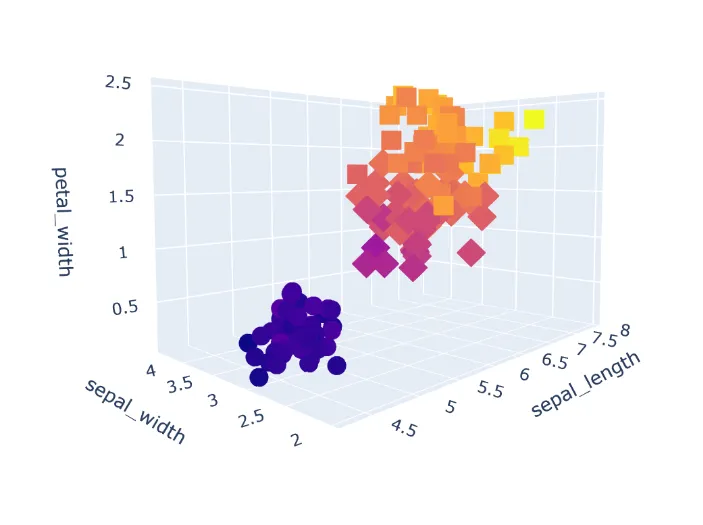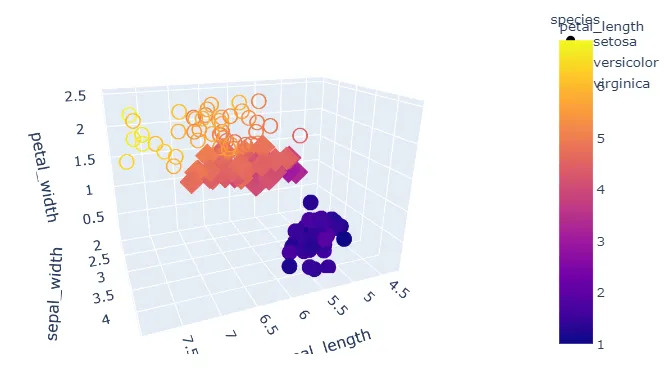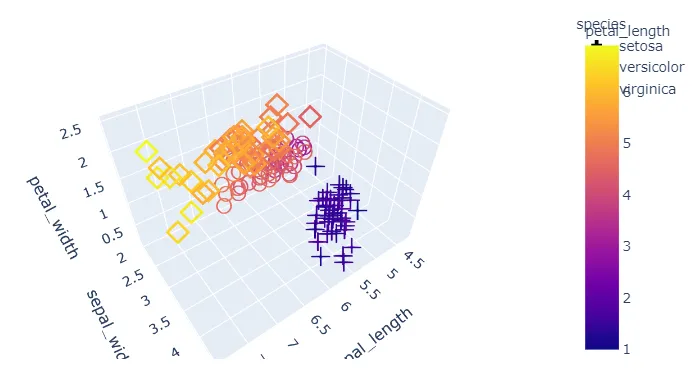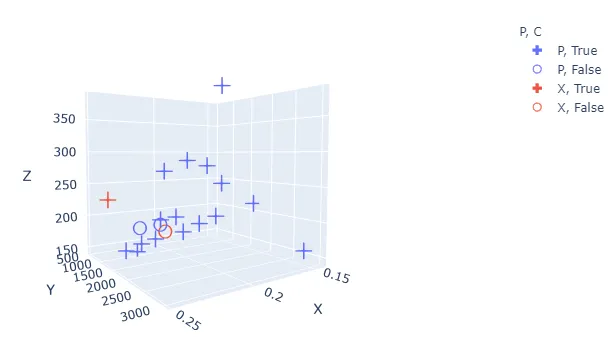在下面的示例中:
更新:
可重现的示例:
import plotly.express as px
df = px.data.iris()
fig = px.scatter_3d(df, x='sepal_length', y='sepal_width', z='petal_width',
color='petal_length', symbol='species')
fig.show()

symbol是由圆形、菱形和正方形所代表的“物种”决定的。当样本数量较大且样本点涂抹在图中时,这可能不是很清晰。我们如何自定义符号,比如使用圆形、正方形和十字形(或其他对比形状组合)?
更新:
我将代码应用于另一个数据集,代码如下:
fig = px.scatter_3d(df8, x='X', y='Y', z='Z',
color='P', symbol='C')
# specify trace names and symbols in a dict
symbols = {'True': 'cross',
'False':'circle-open'}
# set all symbols in fig
for i, d in enumerate(fig.data):
fig.data[i].marker.symbol = symbols[fig.data[i].name]
fig.show()
其中C有两个值:True或False。然而,它捕获了错误:
---------------------------------------------------------------------------
KeyError Traceback (most recent call last)
<ipython-input-183-ea1e2ec7dd8e> in <module>
36 # set all symbols in fig
37 for i, d in enumerate(fig.data):
---> 38 fig.data[i].marker.symbol = symbols[fig.data[i].name]
39
40 fig.show()
KeyError: 'P, True'
更新:
可重现的示例:
{'ID': {0: '672590',
1: '672120',
2: '672090',
3: '672349',
4: '672453',
5: '672560',
6: '672051',
7: '880505',
8: '672593',
9: '880097',
10: '891458',
11: '672091',
12: '672569',
13: '672603',
14: '790030',
15: '672350',
16: '673480',
17: 'I00042',
18: '880297',
19: '894620'},
'X': {0: 0.20111215435497176,
1: 0.21248998904335528,
2: 0.2086689759935364,
3: 0.22337836085443835,
4: 0.17847099434376115,
5: 0.24827331723865761,
6: 0.14411891907440183,
7: 0.20863940038267367,
8: 0.166299824101773,
9: 0.20548401328860527,
10: 0.18007828100726822,
11: 0.21887731187605308,
12: 0.1971207940494219,
13: 0.19247420041228508,
14: 0.21605657330040987,
15: 0.15779241902165092,
16: 0.22536060645732897,
17: 0.19268784843224268,
18: 0.2400112771421119,
19: 0.22548124117213691},
'Y': {0: 2473.923076923077,
1: 2031.1538461538462,
2: 2383.1923076923076,
3: 1830.7692307692307,
4: 1780.2307692307693,
5: 1194.8461538461538,
6: 1641.0,
7: 1563.3076923076924,
8: 1246.2307692307693,
9: 931.6153846153846,
10: 1207.076923076923,
11: 799.6538461538462,
12: 560.8461538461538,
13: 1158.076923076923,
14: 1221.6923076923076,
15: 3030.076923076923,
16: 1178.076923076923,
17: 552.3846153846154,
18: 1380.3076923076924,
19: 1027.5384615384614},
'Z': {0: 385.84615384615387,
1: 288.46153846153845,
2: 281.9230769230769,
3: 273.61538461538464,
4: 252.0,
5: 231.69230769230768,
6: 213.30769230769232,
7: 203.3846153846154,
8: 191.07692307692307,
9: 189.46153846153845,
10: 181.07692307692307,
11: 176.76923076923077,
12: 173.30769230769232,
13: 169.6153846153846,
14: 166.15384615384616,
15: 165.30769230769232,
16: 160.53846153846155,
17: 159.84615384615384,
18: 159.0,
19: 145.3846153846154},
'C': {0: True,
1: True,
2: True,
3: True,
4: True,
5: True,
6: True,
7: True,
8: True,
9: True,
10: True,
11: False,
12: False,
13: True,
14: True,
15: True,
16: True,
17: False,
18: True,
19: True},
'P': {0: 'P',
1: 'P',
2: 'P',
3: 'P',
4: 'P',
5: 'X',
6: 'P',
7: 'P',
8: 'P',
9: 'P',
10: 'P',
11: 'P',
12: 'P',
13: 'P',
14: 'P',
15: 'P',
16: 'P',
17: 'X',
18: 'P',
19: 'P'}}


